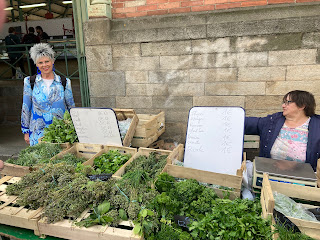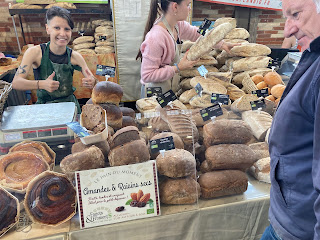On Wednesday we all had to be packed and out of our apartments by 10:00 AM; Hosanna and Matt heading to the airport and then back to LA; Kathy and I grabbing a fast train to Rennes in Brittany. (Hosanna texted us their plane photo while we were onboard the train.)
Our train was a fast TGV train that made the trip to Rennes in just under two hours. At the front of the train car was a flat screen that occasionally showed the speed. Sometimes is exceeded 200 mph.
Rennes is the capital of the area of France known as Brittany. In addition to French, they speak their own language, Breton, one of the six still living Celtic languages (including Welsh, Cornish, Irish, Scottish Gaelic and Manx.) As in Quebec, signs are in both languages (but not in English, unfortunately for me and Kathy). We’re staying for four nights in Rennes, using it as a home base for day trips.
Our hotel is named after Anne of Brittany who was the Queen of France, married to Charles the VIII, and, upon his death, married his successor, Louis XII. (She was also the wife of Maximilian I, the Holy Roman Emperor in 1490, but that was annulled.) Our hotel room was clean and spacious, and was less than half the price we paid in Paris.
It was about 15 minutes (walking) from Rennes old town. Rennes has more old half-timber houses than any other town in Brittany. We followed Google Maps to the Cathedral Saint-Pierre de Rennes. There’s been a church on this site since the 6th century. In the 1100s, a Gothic cathedral was built to replace the original. The Gothic church collapsed in 1490, and the current church was built in a neoclassical style.
For the next thousand years, the interior of the church was modified and elaborated, and today, it looks almost more Byzantine to my eyes, than Roman or Renaissance.
Beside the Cathedral the old town also has the best dining scene. Since ii was after 5:00 PM, we went looking of someplace to eat. Again and again, the places we found didn’t open until 7:00 PM. In Paris, because of the number of tourists, the 12-2 and 7-10 eating schedule was not so strictly enforced. Finally around 6:00 we happened upon the Creperie L’Epi de Ble (Ear of Wheat). When we asked if they were serving food, we were thrilled when they showed us to a table.
The traditional food in Brittany is the Galette, or savory buckwheat crepe. I had mushrooms, cheese and egg while Kathy had mushrooms, cheese and cream sauce, and salad. In addition I had the traditional apple cider which is drunk out of what look like coffee cups. All of it was delicious.
Visiting Saint Michel
Yesterday we saw Saint Pierre’s church. Today we set aside for visiting Saint Michel’s Abbey. A month before we left on our trip I purchased bus tickets from Keolis Armor which runs several daily bus lines between Rennes, Mont St. Michel and Saint Malo.
The first bus left at 8:30 and dropped us in the parking lot of the Abbey. We went into the information center and bought two tickets to tour the abbey itself (around $20 each). You can walk from the parking lot, or you can take the free shuttle bus. We decided we would take the shuttle on the way back.
My first surprise was that there were no elevators. Haven’t they heard of the ADA? The steep main road to the abbey is lined with eateries and the normal mercantile trade that, truthfully, probably hasn’t changed much since pilgrims made the trek in the Middle Ages.
It really is steep. I’d guess that three fourth’s of the people we passed turned around and didn’t enter the Abbey itself.
When we got to the Abbey, there was a service going on in the main church. The sound of the singing nuns was haunting. The church is at the very pinnacle of the rock, and its spire reaches a total of 557 feet above sea level.
The view from the top is awe inspiring. From the terraces on either side we could look down on nesting gulls and small moths that look almost exactly like hummingbirds, flitting from blossom to blossom. (At first we thought that they were hummingbirds until we looked them up.)
After that, we had fifteen other rooms to see, climbing up, and climbing down. This is the cloisters, the covered walkways that surround the central garden. This separated the monks from the outside world, and is from this that we get the term “the cloistered life”.
This is the refectory or dining hall, built between 1211 and 1218, where the monks ate. It reminds me a little of the refectory where The Last Supper is frescoed on the wall in Milan.
Notice the graceful ceiling and pillars here. I believe that this is The Knight’s Hall, a reference to the Order of Saint Michael, founded by Louis XI in 1469, with its headquarters in the Abbey.
The oldest parts of the Abbey are the three crypts that were not discover until the end of the 19th century. The most impressive of these is the Crypte des Gros Piliers, whose ten pillars are indeed gross, since they hold up the Abbey above them.
In the 15th-19th centuries, Mont-Saint-Michel did double duty as a prison. This giant “hamster wheel” was used by the inmates to haul their provisions to the prison.
After leaving the Abbey, we stopped in the gardens and ate the sandwiches we had packed for lunch. Instead of walking back to the parking area, we took the shuttle. On the way back to Rennes, both of us dozed off. When we got back to town, we once again went to the “Ear of Wheat” creperie and shared a savory galette, and had a sweet chocolate cream with ice cream and whipped cream crepe for desert.
Visiting Saint Malo
When I was reading one of the travel forums on Rick Steve’s Website, one of the posters commented on a week long rail pass she had used the previous year in Brittany. After researching it (with much help from Google translate) I found the pass which cost 100 Euros and was good for unlimited travel, for one week, for five people, on the local (TER) trains. Such a deal.
On Friday, the 13th, we hopped on a train for the hour-and-a-half ride to the French Privateer town of Saint Malo. This town was also the scene of the Pulitzer-Prize-winning World-War II novel, All the Light We Cannot See. (Kathy checked the book out from Libby and is listening to it now.) When we got to the Saint Malo train station we walked a mile to the city gates. Along the way, we found this billboard encouraging me to pick up after my dog.
Once inside the city, we stopped for lunch at one of the creperie/brasseries inside the ramparts. Despite its pretty good rating, be both were a little disappointed with the food.
What we really came for, though was to walk the ramparts around the city. The ramparts started to be erected in 1144 and have been updated continuously. Unlike the city walls in Dubrovnik, the city fathers of Saint-Malo haven’t attempted to monetize the attraction, so there is no admission charge. As you can see from my pictures, there aren’t a lot of people either.
At low tide the boats in the harbor rest on the mud. Notice the cruise ship in the background.
Once around to the sea-ward side, there are several interesting beaches, including Plage du Mole which was featured in the Netflix adaptation of All the Light We Cannot See.
The main beach, Plage de Bon-secours features a huge, sea-water filled swimming pool that is refreshed each high tide, as well as the Ile du Grand Be, which contains the remains of an ancient fort and the grave of Francois-Rene de Chateaubriand, a French writer from Saint Malo.
Leaving Saint-Malo I took one last picture of a fearless seagull, and we caught the bus to the train. (You didn’t need a ticket; you just tap your credit card. Unfortunately, I tapped thrice instead of twice. Oh well.)
When we got back to Rennes, we stopped by a Kebap shop next to the hotel, called Berliner, where we got a sandwich to take back to our room. I liked this poster of Monty Burns in the window.
The Marche de Lices
On Saturday we had two tasks: to visit the second largest market in all of France, and, to spend the afternoon in the medieval town called Vitre, about a half-hour east of Rennes.
The Marche de Lices (Walk of the Lists in English) is one of the oldest and largest markets in France. There are acres of produce…
…exotic processed beans and vegetables and spices from Africa…
…olives…
…fresh herbs…
…all kinds of mushrooms and truffles…
…fresh bread…
…more cheeses than you could ever eat…
…rotisserie chickens and any kind of meats…
…and, of course, any kind of fresh seafood. I think that our friend, Hourik Kazarian (a noted cook) would think she had died and gone to heaven.
After the market we went to the train station to catch the train to Vitre. I had checked the schedule earlier in the week and saw that the trains ran every half hour. Unfortunately, I didn’t check the Saturday schedule, which were only a few times a day. So, instead, we decided to go to a Boullion (soup kitchen) restaurant, whose menu we had seen earlier in the day. When we got there, the waiter handed us a much higher-priced menu. Kathy insisted on the menu that was displayed on the street. In the end, the food was OK, but we felt pretty awkward. The people next to us ordered a large boat filled with shrimp and crabs.
Heading Home
Earlier in the week, I caught a cold that moved into my chest. We’ve gone several times to the pharmacy to get cold medicine, but it doesn’t really seem to be going away. We had planned to spend five more days in Brittany, but both of us decided that we’ve seen enough of France for this year.
So, we called Delta and found we could exchange our tickets for next Tuesday’s flight. I was also able to exchange our TVG tickets back to Paris for two seats on the Sunday 7:48 AM train. All the other trains on Sunday and Monday were filled. Finally, I was able to cancel our hotels in Quimper and Vannes, and rent a room at the Ibis Styles at the airport. (Kathy says that the room reminds her a little of a pod-hotel). So, early Sunday morning we got to the train station, and Kathy took one last picture of this statue of a pair of horses drinking with their reflection.
We got to the airport hotel around 11:00 am and were able to check in. We went to another hotel for dinner. Today, we had a great breakfast, one of the best that I’ve had at a hotel. Tomorrow, we’ll be on the plane home. It’s been a great trip, but we’re learning that we’re not 70 any more.





















































